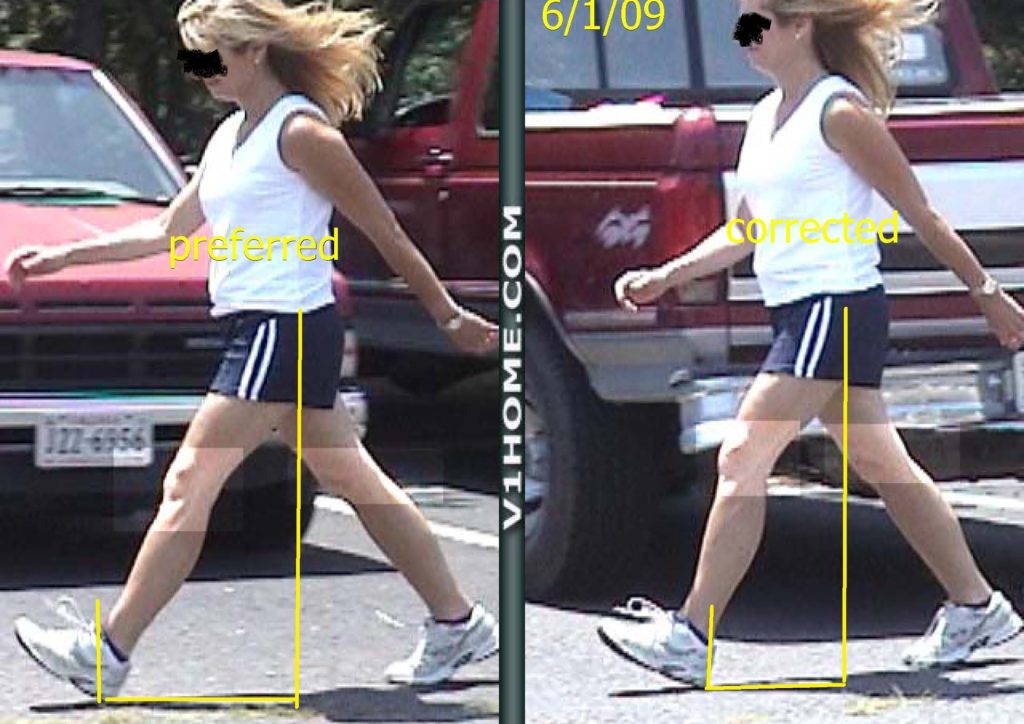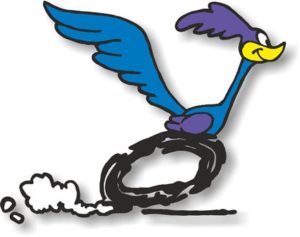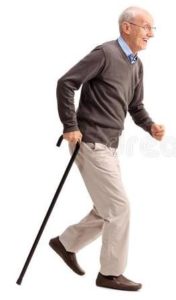Cuing to Alter Gait Deviation of Too Long a Step

Cuing to Alter Gait Deviation of Too Long a Step
Mathematics helps explain walking or running faster.
Step length X steps per minute = speed.
In order to move faster there are 3 opportunities take longer steps or strides, increase the steps/minute (cadence), or do both longer steps and a faster cadence.
Taking longer steps/stride has an inherent risk. The biomechanics of taking longer steps/strides requires a bit more up down motion in addition to the forward motion this can result in an increase in the amount of deceleration forces when the foot hits the ground. The mechanics of taking longer step or stride leads to an increase in shock when the foot hits the ground.
There is a strong relationship between the gait deviation of walking or running with too long a step and injury. When a step is too long is determined by how far out in front of the body is the foot strike. The farther out in front the more likely the step length is too long. The closer the foot strike is to the body the step length is not considered deviant. The image below on the left step length is too long; image on right is conscious effort to shorten step length.

Walking or running with too long a step is correlated with the development of heel pain, shin pain, stress fractures, knee pain, hip pain, and back pain.
Generally speaking the length of step of an individual is instinctual and automatic. Rarely do we consciously choose to walk or run with a certain step length. We do consciously decide to walk or run faster. I am not sure why but when individuals strive to walk or run faster there appears to be a default towards proportionally increasing the step length more than keeping the step length the same and increasing the cadence. The result is a common gait deviation of too long a step or stride.
Cueing or prompting in an effort to alter a gait deviation has been shown to be effective. It is common practice for Physical Therapist to cue clients to alter observed gait deviations in an effort to decrease or eliminate pain. It is common practice for coaches to cue or prompt athletes to alter their form in improve sports performance.
The level of complexity of cueing or prompting varies from “don’t do that” to the use of 3 dimensional virtual reality simulators to provide immediate feedback regarding performance of a skill or task
Which type of cueing or prompting is most effective and efficient is an area of discussion among Physical Therapist and coaches. It is suggested that certain types of cueing or prompting are more potent with longer lasting effects.
Internal versus External Cuing:
Motor learning research suggests that an individual’s attention or focus affects the outcome. A focus or cue can be internal or external. Internal cue is focused attention or consciousness to movement effect or the process. For example, when your foot hits the ground the knee should have a slight amount of bend, not fully straight is an internal cue. It describes the process. The focus is in the body. An external cue is focused on the performance of the movement or the outcome. For example walk or run at a certain number of steps per minute is the performance or the outcome. The assumption is keeping the speed the same if you increase the cadence than the step length must decrease. A common technique is to use a metronome or music with beat per minute set at the desired cadence. This is called cadence training. This focus is external to the body.
The consensus opinion is external focus or cueing is more effective and longer lasting than internal cueing.
Implicit Learning:
Implicit learning is at subconscious level, requires a minimal amount of attention, and is learning without awareness. Learning to walk is used as an example of implicit learning. Some learning occurs without cueing or prompting. Whereas explicit learning is at a conscious level, typically requires a therapist or coach. It involves an awareness and attention. The thinking is gait retraining should occur with very simple short cueing or prompting that requires little attention of focus. Noted coach Roy Benson uses the following technique to coach runners to switch from a heel strike running to a mid-foot strike running. Run or jog in place, then take off running and hold the same form. Running in place automatically results in no heel strike running form. Running in place automatically means short steps.

Walking or running with a partner who has the same stature height and inseam measurement, and who has a more ideal step length and cadence can result in a melding or imitation of the manner of walking or running. If your partner looks good maybe some of it will rub off. This may happen a minimal amount of attention, implicit learning.
Motor Learning theory suggests individuals have a preferred learning sense. Some individuals learn better by listening hearing (auditory sense), some by seeing (visual sense), and some by physically feeling (kinesthetic sense). For individuals who learn better visually cues or prompts need to include an image or picture of what is expected. Presenting cues or prompts with visual image may enhance the learning experience. Cues or prompts to take shorter steps more steps per minute presented with a visual image are as follows:
Visual/Images:
Walk or run and image you are stepping on every railroad tie of railroad track

Look like you are scurrying

Gait deviation of walking or running with too long a step can be a contributing factor to low back pain, acetabular labral injury, gluteal tendinopathy, hip bursitis, patella femoral arthralgia, IT band syndrome, stress fracture, and plantar heel pain. Cuing prompting to take shorter steps and more steps per minute can alter the gait deviation of taking too long a step, and can help alleviate musculoskeletal pain syndromes. The wording used to cue of prompt alterations in gait can affect how effectively and efficiently the gait changes happen. Words matter.
A on demand-video webinar exploring this topic is available at Plus by Physiopedia entitled “Interventions for gait deviations”.
Use this code – “Damien30” for a 30% discount to access this webinar as well as the more than 500 continuing education webinar courses available at Plus by Physiopedia. This is the link http://bit.ly/DAMIEN30 with the 30% discount code embedded.
Damien Howell Physical Therapy – 804-647-9499 – Fax: 866-879-8591 At-Home, At Office, At Fitness Facility, I come to you, I do home visits, or Online Damien@damienhowellpt.com

